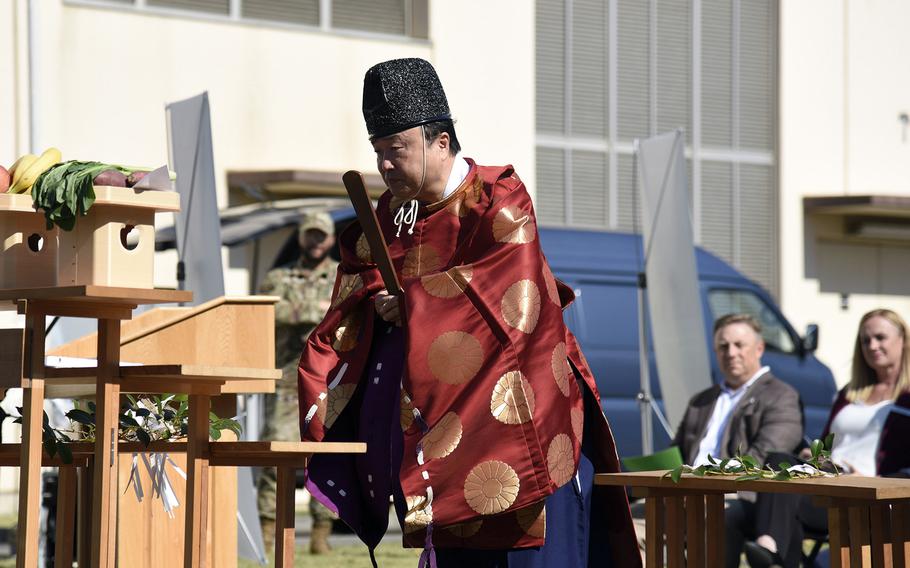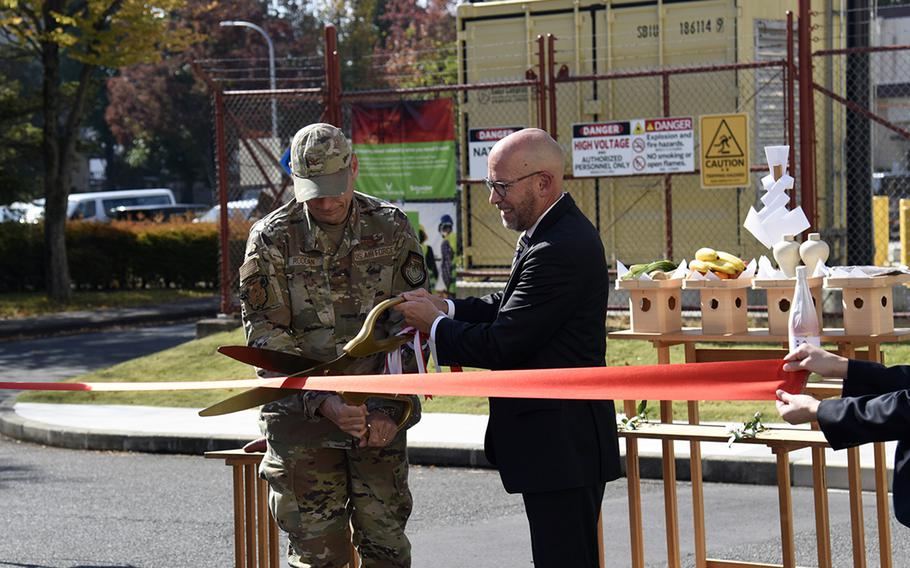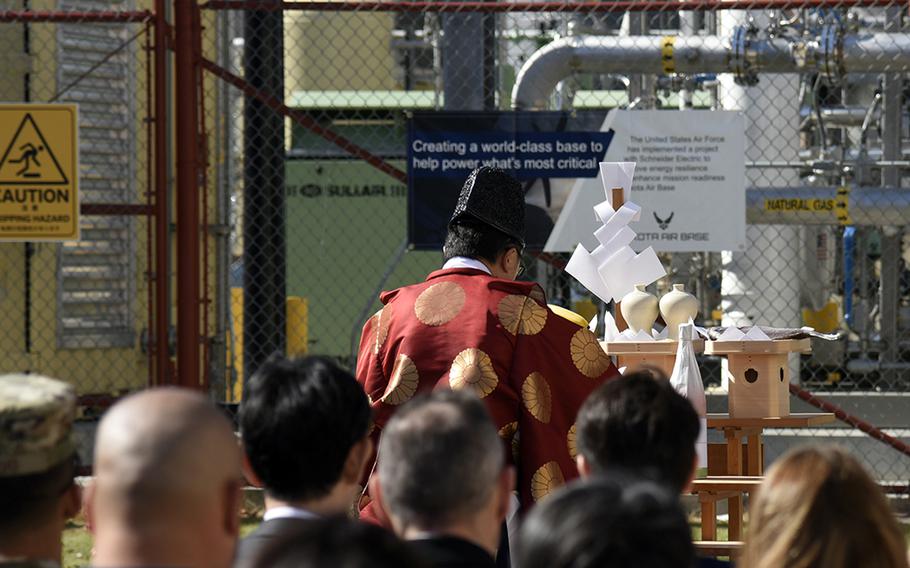
A Shinto priest from nearby Kumagawa Shrine begins the dedication ceremony for a combined heat and power plant at Yokota Air Base, Japan, Friday, Nov. 3, 2023. (Juan King/Stars and Stripes)
YOKOTA AIR BASE, Japan — A ceremony that began with a Shinto blessing signaled the completion Friday of a combined heat and power plant designed to give this airlift hub in western Tokyo energy independence in the event of a crisis.
The plant, which took three years to plan and two years to build under a contract with Schneider Electric, a French firm with U.S. subsidiaries, can generate 10.72 megawatts to power a base microgrid, an independent power supply in the event the surrounding Japanese utilities lose or reduce power.
Ten million watts can power about 2,000 homes per day, according to rough estimates. At Yokota, that power would maintain mission-essential systems.
The project also installed a modern glass-panel centralized control system and made other improvements to heating and lighting systems. Under the contract terms, Schneider also supplies 21 years of operations, maintenance and other services.
“I’d like to thank Schneider Electric for modernizing our control systems and increasing the resiliency of Yokota Air Base,” Col. Andrew Roddan, commander of the 374th Airlift Wing, said during the ceremony outside the new power generating station adjacent to the Yokota Community Center.

Col. Andrew Roddan, commander of the 374th Airlift Wing, and James Potach, senior vice president of Schneider Electric Sustainability Business, officially open a combined heat and power plant at Yokota Air Base, Japan, on Nov. 3. (Juan King/Stars and Stripes)
“This project is a testament to the power of innovative energy solutions in strengthening the capabilities in U.S. armed forces in helping to ensure our continued success protecting national interests of both the United States and our allies and partners around the globe,” he said.
Keeping with Japanese culture and tradition, a Shinto priest from nearby Kumagawa Shrine began the dedication ceremony with a traditional blessing.

A Shinto priest from nearby Kumagawa Shrine begins the dedication ceremony for a combined heat and power plant at Yokota Air Base, Japan, on Nov. 3. (Juan King/Stars and Stripes)
The natural-gas fired, steam-powered generator creates electricity; the steam is then added to the existing heating system on base as a by-product, according to James Potach, senior vice president of Schneider Electric Sustainability Business.
Worth $403 million, the energy savings performance contract to build and maintain the plant is the sixth largest awarded by the Department of Energy to date, according to Alison Rucker, director of federal performance contracting for Schneider Sustainability.
A performance contract means the builder is paid from the savings the project is expected to generate, an estimated $12.3 million a year, with carbon dioxide emissions reduced by 33,000 metric tons, according to Schneider.
“This is a huge project; most of our construction projects typically average $500,000,” Mary Barfield, 374th Civil Engineer Squadron engineering flight chief, told Stars and Stripes after the ceremony. “This is a $166 million construction project, so the size and scale of it is a lot bigger than what we normally manage.”
Barfield oversees contracted construction projects on base.
“It’s a really complex machine and really complex piece of equipment,” she said. “So, we kind of worked through a lot of problems such as transportation during construction, so it’s really great to see it coming together.”
In one such challenge, the plant’s 65-ton packaged electrical control module, loaded inside an AN-124 Antonov, the world’s largest cargo plane, with millimeters to spare, arrived at Yokota on April 13, 2022.
Construction caused a series of power outages and road closures at Yokota, Barfield said. But the outcome will benefit the community.
During the 2011 Tohoku earthquake and tsunami, demands on the grid forced Japanese operators, such as the Tokyo Electric Power Co., or TEPCO, to choose where to provide power, according to an article about the project on the air base website. The new plant could eliminate this problem.
“If there were some disruption off base, we could go into ‘island mode,’ “ Barfield said. “We could disconnect from TEPCO, and we produce our own power, and it would provide power for the majority of the main base with backup power.”
The ceremony concluded with Roddan and Potach cutting a ribbon.
“This project really represents the essence of national security,” Potach said. “We’re really grateful to help you to impact your carbon footprint, your energy efficiency and your mission readiness through energy resilience.”